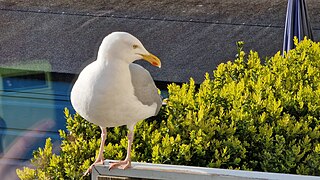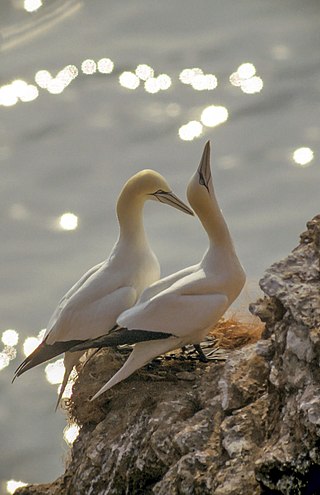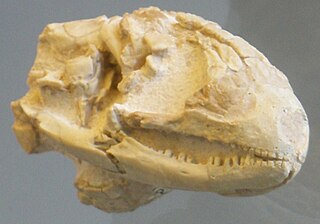
Pteranodon is a genus of pterosaur that included some of the largest known flying reptiles, with P. longiceps having a wingspan of over 6 m (20 ft). They lived during the late Cretaceous geological period of North America in present-day Kansas, Nebraska, Wyoming, South Dakota and Alabama. More fossil specimens of Pteranodon have been found than any other pterosaur, with about 1,200 specimens known to science, many of them well preserved with nearly complete skulls and articulated skeletons. It was an important part of the animal community in the Western Interior Seaway.

Charadriiformes is a diverse order of small to medium-large birds. It includes about 390 species and has members in all parts of the world. Most charadriiform birds live near water and eat invertebrates or other small animals; however, some are pelagic (seabirds), others frequent deserts, and a few are found in dense forest. Members of this group can also collectively be referred to as shorebirds.

Knox County is a county in the U.S. state of Nebraska. As of the 2020 United States Census, the population was 8,391. Its county seat is Center. Knox County was named for Continental and U.S. Army Major General Henry Knox. In the Nebraska license plate system, Knox County is represented by the prefix 12.

Grebes are aquatic diving birds in the order Podicipediformes. Grebes are widely distributed freshwater birds, with some species also found in marine habitats during migration and winter. Most grebes fly, although some flightless species exist, most notably in stable lakes. The order contains a single family, the Podicipedidae, which includes 22 species in six extant genera.

Gulls, or colloquially seagulls, are seabirds of the subfamily Larinae. They are most closely related to terns and skimmers, distantly related to auks, and even more distantly related to waders. Until the 21st century, most gulls were placed in the genus Larus, but that arrangement is now considered polyphyletic, leading to the resurrection of several genera. An older name for gulls is mews; this still exists in certain regional English dialects and is cognate with German Möwe, Danish måge, Swedish mås, Dutch meeuw, Norwegian måke/måse, and French mouette.

The mimids are the New World family of passerine birds, Mimidae, that includes thrashers, mockingbirds, tremblers, and the New World catbirds. As their name suggests, these birds are notable for their vocalization, especially some species' remarkable ability to mimic a wide variety of birds and other sounds heard outdoors. They are commonly referred to as mimic thrushes but are not, in fact, thrushes.

Starlings are small to medium-sized passerine birds in the family Sturnidae, common name of Sturnid. The Sturnidae are named for the genus Sturnus, which in turn comes from the Latin word for starling, sturnus. The family contains 128 species which are divided into 36 genera. Many Asian species, particularly the larger ones, are called mynas, and many African species are known as glossy starlings because of their iridescent plumage. Starlings are native to Europe, Asia, and Africa, as well as northern Australia and the islands of the tropical Pacific. Several European and Asian species have been introduced to these areas, as well as North America, Hawaii, and New Zealand, where they generally compete for habitats with native birds and are considered to be invasive species. The starling species familiar to most people in Europe and North America is the common starling, and throughout much of Asia and the Pacific, the common myna is indeed common.

Gannets are seabirds comprising the genus Morus in the family Sulidae, closely related to boobies. They are known as 'solan' or 'solan goose' in Scotland. A common misconception is that the Scottish name is 'guga' but this is the Gaelic name referring to the chicks only.

Laridae is a family of seabirds in the order Charadriiformes that includes the gulls, terns, noddies, and skimmers. It includes around 100 species arranged into 22 genera. They are an adaptable group of mostly aerial birds found worldwide.

Larus is a large genus of gulls with worldwide distribution.

The black geese of the genus Branta are waterfowl belonging to the true geese and swans subfamily Anserinae. They occur in the northern coastal regions of the Palearctic and all over North America, migrating to more southerly coasts in winter, and as resident birds in the Hawaiian Islands. Alone in the Southern Hemisphere, a self-sustaining feral population derived from introduced Canada geese is also found in New Zealand.

Smith Falls, at 63 feet, is the highest waterfall in the state of Nebraska and the centerpiece of Smith Falls State Park. The state park and falls are located 12 miles (19 km) east-northeast of Valentine and 3 miles southwest of Sparks, on the south side of the Niobrara River. Access to the falls is via a footbridge across the river from the north side of the park.

Peltosaurus is an extinct genus of anguid lizard from North America that lived from the Eocene to the Miocene. Peltosaurus belongs to the anguid subfamily Glyptosaurinae. The type species Peltosaurus granulosus was named in 1873 by American paleontologist Edward Drinker Cope. Many additional species have been named, but most have been reassigned to different genera. For example, Peltosaurus piger, named in 1928, was reclassified as Odaxosaurus piger, and P. jepseni, named in 1942 from the Paleocene of Wyoming, but was later reclassified as Proxestops jepseni. In 1955 a new species, Peltosaurus macrodon, was named from the Eocene of California. Lizard bones from the Late Miocene of Nebraska were attributed to a new species of Peltosaurus called P. minimus in 1976, extending the fossil range of Peltosaurus and Glyptosaurinae into the Neogene. However, these bones were later referred to a genus of skinks called Eumeces, meaning that the fossil range of Peltosaurus and Glyptosaurinae does not go beyond the Paleogene.
Megapaloelodus is an extinct genus of stem flamingo of the family Palaelodidae. Megapaloelodus is primarily known from Miocene America, from South Dakota and Oregon in the north to Argentina in the south, but the species Megapaloelodus goliath was found in Europe. Additionally, one unnamed species was discovered in Miocene sediments from Namibia. Due to a lack of skull material, little can be said about the ecology of Megapaloelodus. Species of this genus are typically larger than those of Palaelodus and appear to have inhabited similar brackish lake environments. Additionally, they may have been capable of "locking" their legs in a standing position.

Chachalacas are galliform birds from the genus Ortalis. These birds are found in wooded habitats in the far southern United States (Texas), Mexico, and Central and South America. They are social, can be very noisy and often remain fairly common even near humans, as their relatively small size makes them less desirable to hunters than their larger relatives. As agricultural pests, they have a ravenous appetite for tomatoes, melons, beans, and radishes and can ravage a small garden in short order. They travel in packs of six to twelve. Their nests are made of sticks, twigs, leaves, or moss and are generally frail, flat structures only a few feet above the ground. During April, they lay from three to five buffy white eggs, the shell of which is very rough and hard. They somewhat resemble the guans, and the two have commonly been placed in a subfamily together, though the chachalacas are probably closer to the curassows.

Protohippus is an extinct three-toed genus of horse. It was roughly the size of a modern donkey. Fossil evidence suggests that it lived during the Late Miocene, from about 13.6 Ma to 5.3 Ma.
Phlaocyon annectens is an extinct species of the genus Phlaocyon, belonging to the subfamily Borophaginae and tribe Phlaocyonini, a canid endemic to central and western North America from the Late Oligocene to Early Miocene living 24.6—20.8 mya and existed for approximately 4.2 million years.

The Valentine Formation is a geologic unit formation or member within the Ogallala unit in northcentral Nebraska near the South Dakota border. It preserves fossils dating to the Miocene epoch of the Neogene period and is particularly noted for Canid fossils. This unit consists of loosely-consolidated sandstone that crumbles easily. These sands carry the water of the Ogallala Aquifer and is the source of much of the water in the Niobrara River. A particular feature of the Valentine is lenticular beds of green-gray opaline sandstone that can be identified in other states, including South Dakota, Nebraska, Kansas, and Colorado. Although three mammalian fauna stages can be mapped throughout the range of the Ogallala, no beddings of the Ogallala are mappable and all attempts of formally applying the Valentine name to any mappable lithology beyond the type location have been abandoned. Even so, opaline sandstone has been used to refer to this green-gray opalized conglomerate sandstone that is widely found in the lower Ogallala Formation.
Hyperailurictis is an extinct genus of felid from Miocene North America. The Hyperailurictis species are Pseudaelurus-grade felids and thought to be the first felids in the Americas.
Pericotoxodon is an extinct genus of toxodontid notoungulate, from the Miocene period. Fossils of Pericotoxodon were found near Río Inuya and Mapuya in Peru, and in La Venta, Colombia and Bolivia, in deposits dated to the Middle Miocene.


















